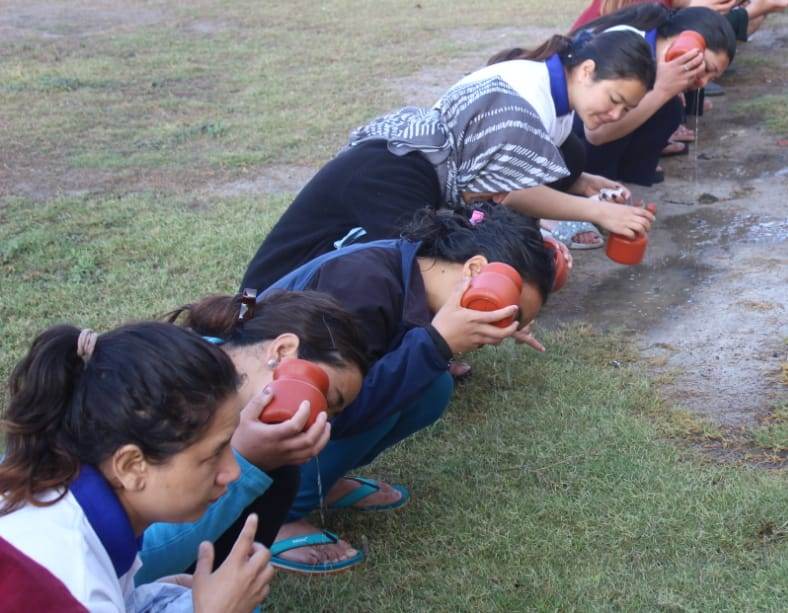
Best yoga poses for sinusitis
1. Sutraneti (Nasal Cleansing with Thread) prevents sinus infection
To cure sinus through natural means, Sutraneti is one of the effective measures. Sutraneti is a one-hand soft cotton thread, which is soaked in bee-wax for nasal cleansing exercise.
How to perform Sutraneti
- First, sit in Kagasana
- Now insert the thread through one of the nostrils, which seems to be more active.
- Try to get it to the back of the throat, catch the sutra, and bring it out from the mouth.
- Slowly and gently make the movement of thread forward and backward.
- Continue it for 10 rounds.
- Take the thread out and repeat the same with the other nostrils.
Sutraneti Benefits
- It helps to cure sinus.
- It’s a Yogic exercise to cleanse brain cells.
- It’s effective for head region related disease.
- It improves the functions of the eyes and nasal regions.
- It helps to clear the nasal passage that ensures a smooth flow of air.
Sutraneti Precautions
- Sutraneti should be performed once a week.
- The thread should be clean
- Perform it slowly and gently.
- It should be practiced before Pranayama.
- Having nasal problems i.e. nose bleeding should consult the expert before practicing it.
2. Jalaneti (Nasal Cleansing with Water) for sinus prevention
Jalaneti is quite an effective Yogic practice to cure headaches, insomnia, cough & cold, and drowsiness. Basically, it’s the nasal cleansing exercise with lukewarm salted water.

How to perform Jalaneti
- Take a Neti pot
- Salted lukewarm water (1 tsp salt in ½ litre water)
- Sit in Kagasana with a gap of 2 feet between the feet.
- Tilt the head and insert the neti pot nozzle into the active nostril. Let the water flow through this nostril and ensures to release through another nostril.
- While performing the exercise, your mouth should be opened and the body is relaxed.
- After completing through one of the nostrils, continue the same with another one.
Benefits of Jalaneti
- It is good in the prevention of hair fall.
- Jalaneti is extremely beneficial in case of chronic headache, insomnia, and drowsiness.
- It helps to enhance memory.
- Good against cough and cold.
- It is beneficial for eyes related problems.
Precautions of Jalaneti
- To dry your nose, the better way is to perform Bhastrika Pranayama.
- An appropriate quantity of salt should be added as too much or too little salt may lead to a burning sensation.
- Continued mouth breathing throughout the exercise.
3. Kapalabhati (Frontal Brain Cleansing Exercise) to fight sinus problems
Kapalabhati consists of two words: Kapala means skull while Bhati means to shine. Thus, it’s a yogic exercise to shine skull. It helps to improve mental functions; refresh and rejuvenates the head region. One should practice Kapalabhati before Pranayama as it ensures a smooth flow of oxygen and carbon dioxide. In Kapalabhati, inhalation is passive and spontaneous while exhalation is forceful.
How to perform Kapalabhati
- Sit in any meditative posture.
- Inhale deeply and exhale forcefully with the contraction of abdominal muscles.
- Now inhale is passive & spontaneous while exhaling is forceful.
- Continue it for 10 minutes. (Initially 2 to 3 minutes.)
- While performing Kapalabhati, there shouldn’t be movement of your shoulders.
- Your face should be cool, calm, and relaxed.

Kapalabhati
Benefits of Kapalabhati
- It is a wonderful yoga to relieve sinus problems.
- Kapalabhati is one of the finest exercises for clearing respiratory blockages.
- If it continues for 10 minutes for a longer period of time, it helps in weight loss.
- It is helpful in treating cold, cough, rhinitis, sinusitis, and respiratory related problems.
- It gives smooth massage to the abdominal organs thus helpful in curing digestion-related disorders.
- It is useful to enhance memory.
- It increases the lung’s capacity.
- It is the panacea to contend mucous disorders.
Precautions of Kapalabhati
- One shouldn’t practice Kapalabhati of having hyperacidity.
- High blood pressure patients should avoid it.
- It should be avoided if the practitioners have cardiac conditions, giddiness, vertigo, epilepsy, stroke, and hernia.
4. Bhastrika Pranayama for Sinusitis Cure
The word Bhastrika is derived from Bhastra means bellows where inhalation and exhalation happen with rapid force. Bhastrika Pranayama is good to relieve cold and congestion in the nasal area.

How to perform Bhastrika Pranayama
- Sit in any meditative posture, preferably in Padmasana.
- Initially inhale and exhale slowly.
- After then start forceful inhalation and exhalation just like blacksmith’s bellows. At the end of rounds, take a deep inhalation followed by Kumbhaka (retention of breath), exhale slowly.
- Relax and do normal breathing, again start the above process 10 times.
- A total of three rounds may be formed initially.
- While performing this Pranayama, a hissing sound is also coming out because of its powerful intensity.
Bhastrika Pranayama Benefits
- Bhastrika Pranayama provides sinus relief.
- It is the single Pranayama which is quite effective in reducing weight and belly fat.
- It overcomes throat inflammation.
- It is helpful in the cleansing of nasal sinuses, phlegm, and prevents asthma.
- It increases gastric fire.
- It is also good to increase appetite.
Bhastrika Pranayama Precautions
- Those who suffered from high blood pressure, heart disease and stomach ulcer shouldn’t practice it.
- It should be performed either in the morning or evening.
- After performing the Pranayama, one must practice either Sitkari or Sitali Pranayama as Bhastrika overheat the body.
5. Anulom Vilom Pranayama to get rid of Sinus
Anulom Vilom is also known as Nadisodhana Pranayama. This practice purifies the Nadis by removing the congestion thus ensures the free flow of prana in the nadis.

How to perform Anulom Vilom Pranayama
- Sit in any comfortable position
- Make sure that your back and neck is straight.
- Placed your right thumb on your right nostril and slowly inhale through the left nostril. Closed your left nostril and exhale very slowly through the right nostril
- Now inhale through the right nostril and exhale through the left nostril slowly.
- This completes one cycle.
- Perform 10 such cycles initially; it may be increased with time.
- While performing, one should close one’s eyes.
Benefits of Anulom Vilom Pranayama
- It removes congestion from the Nadis (energy channel) thus ensures the free flow of energy throughout the body.
- It is helpful in curing nasal congestion.
- It facilitates blood flow to the brain.
- It is the stress buster and makes one cool and calm.
- It is an immunity booster.
- It directly affects the calming center of the brain.
- It channelizes the smooth flow of oxygen to the entire body.
- It is one of the few Pranayamas that prevents many diseases and disorders.
Precautions of Anulom Vilom Pranayama
- One shouldn’t practice Kumbhaka in the preparatory stage of this pranayama.
6. Suryabhedi Pranayama to prevent sinus
The meaning of Surya is Sun and Bhedand means to pierce. Suryabhedi Pranayama cures rhinitis and kills the germs and worms that are found in the sinus region.
How to perform Suryabhedi Pranayama
- Sit in any comfortable position.
- Closed your left nostril with your ring and little fingers.
- Slowly inhale through the right nostril without making any sound.
- Hold the breath (Kumbhaka) as long as you can do.
- Exhale slowly through the left nostril.
- This is one round. Perform it many rounds.
Suryabhedi Pranayama Benefits
- It is helpful in giving instant relief to sinusitis.
- It cures rhinitis and useful in the smooth functioning of sinuses.
- It kills the intestinal germs.
- It helps to increase the bodily fire.
- It helps to delay old age and death.
- It increases blood pressure therefore good for low blood pressure patients as it activates the sympathetic nervous system.
Suryabhedi Pranayama Precautions
- It shouldn’t be performed who has high blood pressure.
7. Gomukasana (Cow’s Face Pose) to reduce sinus symptoms
How to perform Gomukasana
- Sit erect
- Fold the left from the knee and bring your left heel to the side of the right buttock.
- Now fold the right knee and bring the right heel to the side of the left buttock.
- Raise the left arm by bending it at the elbow and place it at the back of the shoulder from below while the right arm by bending at the elbow has to take from upward and behind the back.
- Interlock the finger of both the hands at the back.
- Stay in the position as long as you can by gazing front.
- Repeat it by changing the position of both the hands and legs.
- Do five rounds.
Benefits of Gomukasana
- This is good for respiratory diseases including sinus.
- It is good in making the spine supple, flexible, and straight.
- This asana is helpful for joint arthritis.
- This can be practiced who is facing frozen shoulder, neck pain, and cervical spondylitis.
Precautions of Gomukasana
- A person suffering from piles should avoid it.
8. Bhujangasana (Cobra Pose) to manage Sinus Problems
The meaning of Bhujanga is ‘Cobra’ as the final pose of the asana seems to be Cobra.
How to perform Bhujangasana
- Lie down on the stomach with legs apart.
- Fold your hands at the elbows and bring your palms at the shoulder level.
- Now with inhale raise your head portions till your navel and try to see the roof with your head.
- Maintain the pose with slow inhale and exhale as long as you can.
- Bring down with a deep exhale.
- This is one cycle that does five to seven cycles.
Benefits of Bhujangasana
- This is good for the proper functioning of your lungs thus directly or indirectly affects the sinus
- It is one of the best poses to lose belly fat
- It is good to relieve backache
- It should be practiced by those who are experiencing cervical spondylitis and thyroid.
- It is also quite effective to cure gynecological disorders.
Precautions of Bhujangasana
- It should be avoided if the person is having the problem of hernia and abdominal injuries.
9. Sarvangasana (All Limbs Pose) to ease sinus
Sarvangasana is known as the mother of all the asanas because of its significance and importance. This asana is good at curing and treating many diseases and disorders.
How to perform Sarvangasana
- Lie down in the supine position.
- Raise both the legs slowly at a 90° angle. Try to form a straight line so that your chin may get a touch on your chest.
- Slowly come down to the supine position and rest.
- Practice it 3 to 5 rounds.
Benefits of Sarvangasana
- This yoga pose is good in treating problems related to the head region.
- It delays aging
- It is good to prevent hair fall.
- It is helpful in treating constipation and piles.
- It is useful to prevent the graying of hair.
- It regulates the endocrine glands.
Precautions of Sarvangasana
- People suffering from high blood pressure shouldn’t practice it.
10. Ustrasana (Camel Pose) to treat sinus
How to perform Ustrasana
- Kneel down on the floor.
- Bring your feet one foot apart.
- With inhaling bend backward carefully so that you can able to place your right palm on the right heel and left palm on the left heel.
- Maintain the pose with slow inhale and exhale.
- Come to the original position with a deep exhale.
Benefits of Ustrasana
- It is good for problems related to your head region including the nasal area.
- It improves eyes sight.
- It is beneficial for back pain and neck pain.
- It helps to reduce belly fat.
- It enhances digestion
Precautions of Ustrasana
- It should be avoided who has high blood pressure, cardiac problems, and hernia.






I am trying these for a couple of minutes since my cough is not going since 3 months though it has reduced a lot. Kindly suggest the best breathing exercise for cough and mucus which u get almost constantly.
Preity the best pranayam is
Kalpalbhati, bastrika and nadhi sodhana
Pls which yoga exercise is good to a running nose and red eye
I mean instant relief from a nasal congestion and red eye
Very useful information, thank you!!
apply pure honey with fingers gently into the nose, have a free air swallow. within 3 minutes
total nose block will be clear,also pour small quantity 1 teaspoonfull honey into the mouth.total
block in throat/nose will be cleared.i had a practise past 15 years.